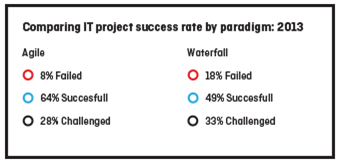In our podcast episode, BI is Not the Same as an ERP Implementation, our VP of Delivery Operations, Caleb Ochs, and CEO, Brick Thompson, discuss the benefits of an agile strategy in BI implementation over the traditional waterfall approach and how to get quick wins while establishing a state-of-the-art BI system.
Having worked with 200+ clients, we’ve noticed a trend: Clients who utilize an agile approach in their dashboard implementations experience a higher rate of success than those who use the waterfall approach.

Statistics confirm this trend (Sweeney, 2022). Ambysoft’s 2013 Project Success Rates Survey found that the agile method has a 15% higher rate of success than waterfall (Ambysoft, 2013).
Drawbacks of Waterfall Methodology
If waterfall delivers a lower rate of success, why do companies continue to use it?
The conventional process goes something like this. When setting out to convert your data into automated dashboards, scope creep is a constant temptation. You meet with a group of stakeholders to discuss creating dashboards to advance a goal or area of constraint in the business. The potential impact becomes evident, along with some seemingly reasonable impulses: “We need to get this right the first time. We can’t forget to address work order efficiency. And we might want to add data that spotlights labor utilization. And oh yes, the finance team will want a version that fits their needs, too.” Consequently, your group drifts into a one-and-done mindset and rallies around a much larger project, energized by the potential to address a broader set of issues in one fell swoop. The budget and timeline swell, the project plan grows in complexity, and the stakeholder group expands. Hello waterfall approach.
Waterfall approaches can be appropriate for complex organizational projects, but that tendency often drifts into BI projects, where point-solutions can be implemented and form the building blocks of a data-driven organization. The outcomes of waterfall projects in terms of cost, timeline, and delayed benefits are commonly unfavorable (Fair, 2012). Most organizations can’t afford these drawbacks, particularly in today’s volatile economy of labor shortages, supply chain issues, and rising inflation. We need quick wins, and in BI, those wins inform each subsequent sprint while delivering value and reducing project risks.
Benefits of Agile Methodology
Enter agile methodology where the focus is a short development cycle, delivering insights quickly, and iterating as in response to the customer’s feedback (Fair, 2012). Agile works especially well for projects that require learning and adjustments along the way, so it partners well with BI, where user’s need to get their hands on a working version in order to clarify their needs (Product Plan, 2022).
Consulting giant PwC’s IT function shifted from the traditional waterfall delivery approach toward agile delivery in 2016, when they went through the process of digital transformation. Since the transition, they’ve experienced positive results. “We shifted from a traditional waterfall delivery approach toward agile delivery using the scrum framework where people work in short sprints and solve problems as they arise, to deliver value quickly and continuously…The agile model is helping to vastly improve the employee experience across our teams, and that is helping lead to better outcomes” (PwC, 2022).
At Blue Margin, we follow best-practices as the forefront of data engineering and dashboard design resulting in rapid delivery and high-impact projects.
Practically, what does this look like?
- Begin each BI initiative by clearly defining the business need and the measurable impact. You don’t need to know everything, but you do need to know what your business wants out of the project.
- Intentionally choose who is (and who isn’t) a key player for decisions, so the process remains as nimble as possible.
- Apply a disciplined process for keeping the scope of the project focused and finite to stay on time and budget, and reduce project risk.
Learn more about getting the most value out of your BI projects from our podcast: The Dashboard Effect.
